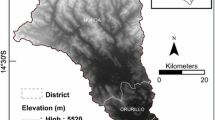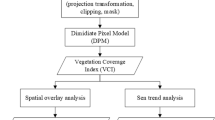Abstract
During the past half century, NDVI has been widely used for vegetation mapping and monitoring as well as in the assessment of land-cover and associated changes. This is because remotely sensed satellite-derived datasets provide spatially continuous data (data that are not sampled at individual points) and yield time-series signatures from which temporal patterns, trends, variations, and relationships may be derived (Jacquin et al. 2010). This has not prevented the misuse of NDVI—care is needed in the use of any scientific methodology.
Access this chapter
Tax calculation will be finalised at checkout
Purchases are for personal use only
Similar content being viewed by others
References
Achard F, DeFries R, Eva H, Hansen M, Mayaux P, Stibig H (2007) Pan-tropical monitoring of deforestation. Environ Res Lett 2(4):045022
Anyamba A, Tucker CJ (2012) Historical perspective of AVHRR NDVI and vegetation drought monitoring. Remote Sens Drought: Innovative Monit Approaches 23
Bai Z, Dent D, Wu Y, de Jong R (2013) Land degradation and ecosystem services. In: Lal R, Lorenz K, Hüttl RF, Schneider BU, von Braun J (eds) Ecosystem services and carbon sequestration in the biosphere. Springer, Dordrecht, pp 357–381
Bandyopadhyay N, Saha AK (2014) Analysing meteorological and vegetative drought in Gujarat. In: Singh M, Singh RB, Hassan I (eds) Climate change and biodiversity: proceedings of IGU Rohtak conference, vol 1. Springer, Japan, pp 61–71
Bradley BA, Mustard JF (2008) Comparison of phenology trends by land cover class: a case study in the Great Basin, USA. Glob Chang Biol 14(2):334–346
Conijn J, Bai Z, Bindraban P, Rutgers B (2013) Global changes of net primary productivity, affected by climate and abrupt land use changes since 1981. Towards mapping global soil degradation. Report 2013/01, ISRIC–World Soil Information, Wageningen. ISRIC Report 1
Cook BI, Pau S (2013) A global assessment of long-term greening and browning trends in pasture lands using the GIMMS LAI3g dataset. Remote Sens 5(5):2492–2512
de Jong R, de Bruin S, de Wit A, Schaepman ME, Dent DL (2011a) Analysis of monotonic greening and browning trends from global NDVI time-series. Remote Sens Environ 115(2):692–702. doi:http://dx.doi.org/10.1016/j.rse.2010.10.011
Farifteh J, Farshad A, George R (2006) Assessing salt-affected soils using remote sensing, solute modelling, and geophysics. Geoderma 130(3):191–206
Field CB, Randerson JT, Malmström CM (1995) Global net primary production: combining ecology and remote sensing. Remote Sens Environ 51(1):74–88
Haboudane D, Miller JR, Pattey E, Zarco-Tejada PJ, Strachan IB (2004) Hyperspectral vegetation indices and novel algorithms for predicting green LAI of crop canopies: modeling and validation in the context of precision agriculture. Remote Sens Environ 90(3):337–352
Holben BN (1986) Characteristics of maximum-value composite images from temporal AVHRR data. Int J Remote Sens 7(11):1417–1434
Jacquin A, Sheeren D, Lacombe J-P (2010) Vegetation cover degradation assessment in Madagascar savanna based on trend analysis of MODIS NDVI time series. Int J Appl Earth Obs Geoinf 12:S3–S10
Karnieli A, Agam N, Pinker RT, Anderson M, Imhoff ML, Gutman GG, Panov N, Goldberg A (2010) Use of NDVI and land surface temperature for drought assessment: merits and limitations. J Climate 23(3):618–633
Krupenikov IA, Dent D, Boincean BP (2011) The black earth: ecological principles for sustainable agriculture on chernozem soils, vol 10. Springer, Dordrecht
Lambin EF, Ehrlich D (1997) Land-cover changes in sub-Saharan Africa (1982–1991): application of a change index based on remotely sensed surface temperature and vegetation indices at a continental scale. Remote Sens Environ 61(2):181–200
Liu W, Juárez RN (2001) ENSO drought onset prediction in northeast Brazil using NDVI. Int J Remote Sens 22(17):3483–3501
Metternicht G, Zinck J (2003) Remote sensing of soil salinity: potentials and constraints. Remote Sens Environ 85(1):1–20
Myneni RB, Hall FG, Sellers PJ, Marshak AL (1995) The interpretation of spectral vegetation indexes. IEEE Trans Geosci Remote Sens 33(2):481–486
Myneni R. B. et al. (2014) Attribution of global vegetation photosynthetic capacity from 1982 to 2014. Global Change Biology (in review)
Olsson L, Eklundh L, Ardö J (2005) A recent greening of the Sahel—trends, patterns and potential causes. J Arid Environ 63(3):556–566
Pettorelli N, Vik JO, Mysterud A, Gaillard J-M, Tucker CJ, Stenseth NC (2005) Using the satellite-derived NDVI to assess ecological responses to environmental change. Trends Ecol Evol 20(9):503–510
Pettorelli N, Safi K, Turner W (2014) Satellite remote sensing, biodiversity research and conservation of the future. Philos Trans R Soc, B 369(1643):20130190
Prince SD, Goward SN (1995) Global primary production: a remote sensing approach. J Biogeogr 22:815–835
Rouse J Jr, Haas R, Schell J, Deering D (1974) Monitoring vegetation systems in the Great Plains with ERTS. NASA Spec Publ 351:309
Running SW, Nemani RR, Heinsch FA, Zhao M, Reeves M, Hashimoto H (2004) A continuous satellite-derived measure of global terrestrial primary production. Bioscience 54(6):547–560
Schlerf M, Atzberger C, Hill J (2005) Remote sensing of forest biophysical variables using HyMap imaging spectrometer data. Remote Sens Environ 95(2):177–194
Sternberg T, Tsolmon R, Middleton N, Thomas D (2011) Tracking desertification on the Mongolian steppe through NDVI and field-survey data. Int J Digital Earth 4(1):50–64
Symeonakis E, Drake N (2004) Monitoring desertification and land degradation over sub-Saharan Africa. Int J Remote Sens 25(3):573–592
Tucker CJ, Nicholson SE (1999) Variations in the size of the Sahara Desert from 1980 to 1997. Ambio 28:587–591
Tucker CJ, Pinzon JE, Brown ME, Slayback DA, Pak EW, Mahoney R, Vermote EF, El Saleous N (2005) An extended AVHRR 8‐km NDVI dataset compatible with MODIS and SPOT vegetation NDVI data. Int J Remote Sens 26(20):4485–4498
Wessels KJ, Prince SD, Frost PE, van Zyl D (2004) Assessing the effects of human-induced land degradation in the former homelands of northern South Africa with a 1 km AVHRR NDVI time-series. Remote Sens Environ 91(1):47–67. doi:http://dx.doi.org/10.1016/j.rse.2004.02.005
Wessels KJ, Prince SD, Malherbe J, Small J, Frost PE, VanZyl D (2007) Can human-induced land degradation be distinguished from the effects of rainfall variability? A case study in South Africa. J Arid Environ 68(2):271–297
Zhang Y, Peng C, Li W, Fang X, Zhang T, Zhu Q, Chen H, Zhao P (2013) Monitoring and estimating drought-induced impacts on forest structure, growth, function, and ecosystem services using remote-sensing data: recent progress and future challenges. Environ Rev 21(2):103–115. doi:10.1139/er-2013-0006
Author information
Authors and Affiliations
Rights and permissions
Copyright information
© 2015 The Author(s)
About this chapter
Cite this chapter
Yengoh, G.T., Dent, D., Olsson, L., Tengberg, A.E., Tucker, C.J. (2015). Limits to the Use of NDVI in Land Degradation Assessment. In: Use of the Normalized Difference Vegetation Index (NDVI) to Assess Land Degradation at Multiple Scales. SpringerBriefs in Environmental Science. Springer, Cham. https://doi.org/10.1007/978-3-319-24112-8_4
Download citation
DOI: https://doi.org/10.1007/978-3-319-24112-8_4
Published:
Publisher Name: Springer, Cham
Print ISBN: 978-3-319-24110-4
Online ISBN: 978-3-319-24112-8
eBook Packages: Earth and Environmental ScienceEarth and Environmental Science (R0)




